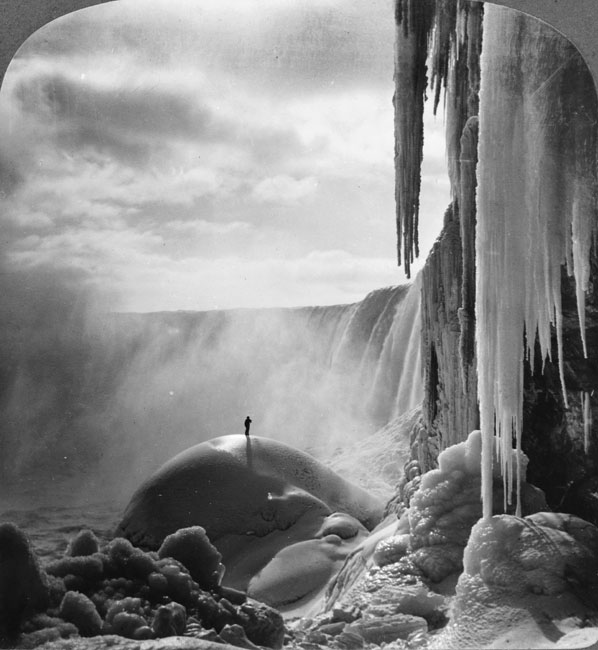
Stereoview photo by R.Y. Young, 1903. Image source: Library of Congress
"Light above the rocks I play,
Where Niagara's starry spray,
Frozen on the cliff appears,
Like a giant's startling tears.
...
Lone I sit, at close of day,
While, beneath the golden ray,
Icy columns gleam below,
Feather'd round with falling snow,"
...
Thomas Moore, Irish poet

Postcard image, c. 1900. Image source: private collection
"When winter has done its worst, and covered the earth with its pure snow mantle, and bound with icy fetters all common streams, the untamable Niagara scoffs at its power, rushes from Lake Erie to the Falls, exulting in its freedom, thunders from the precipice, and sends into the frosty air perpeturally its canopy of mist. The mist sinks slowly down, covering and moistening everything. As it falls, winter asserts its power, and freezes it, into a pearly or crystal covering of every twig, and leaf... Not a sound is heard, but the crashing of our own foot-steps through the icy snow, save when the gentle air sighs through the wood, and the stirred branches touch each other, and emit a tinkling sounds...And when the Sun, throws his beams aslant into the wood, they are caught and broken, by the silver branches, into all the colors of the rainbow, which dance through and fill the air...All you've read of magic gardens, and of fairy land, fictitious though they be, do fall short of real Niagara in winter."
Sketches of Niagara Falls and River, 1846, Geo. W. Clinton (1807-1885) (Son of Dewitt Clinton, mayor of Buffalo 1842-43, U.S. District Attorney for WNY.)

Bridge from Goat Island to Terrapin Point, 1900. Image source: "Grandeurs of Niagara
"In winter the hand of Nature gives a new covering to some of the bridges at Niagara, and this is particularly true of the bridge leading from Goat Island out to Terrapin Point. The spray from the Horseshoe Falls settles in great quantities upon this structure and is there congealed by winter's breath into ice of perfect whiteness. The ice is many inches thick, and when the effect is at its best the bridge appears to be hewn from purest marble." ("Grandeurs of Niagara")
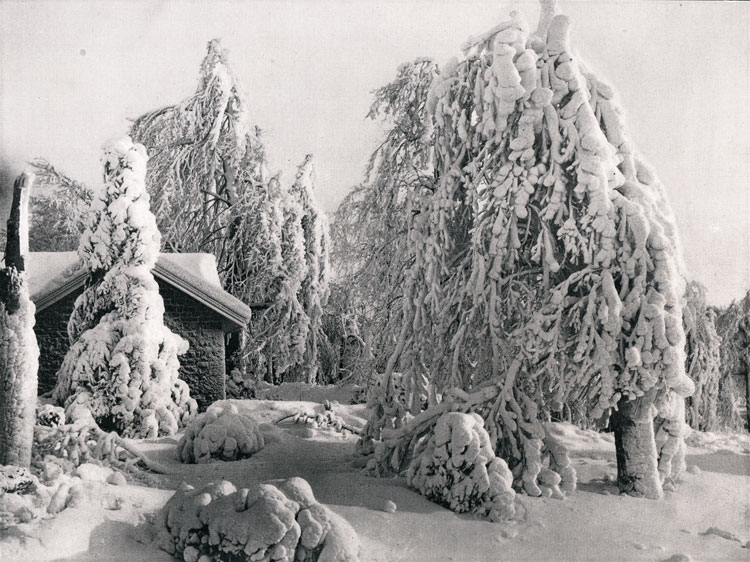
Prospect Park. 1900. Image source: "Grandeurs of Niagara"
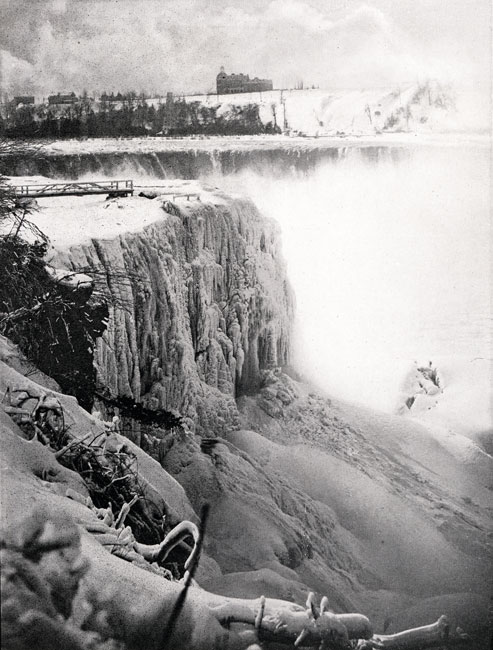
Terrapin Point, 1900. Image source: "Grandeurs of Niagara"
"The frost sparkles like diamonds, and the ice-coated surroundings have a fascinating beauty which once seen is never forgotten." ("Grandeurs of Niagara" )
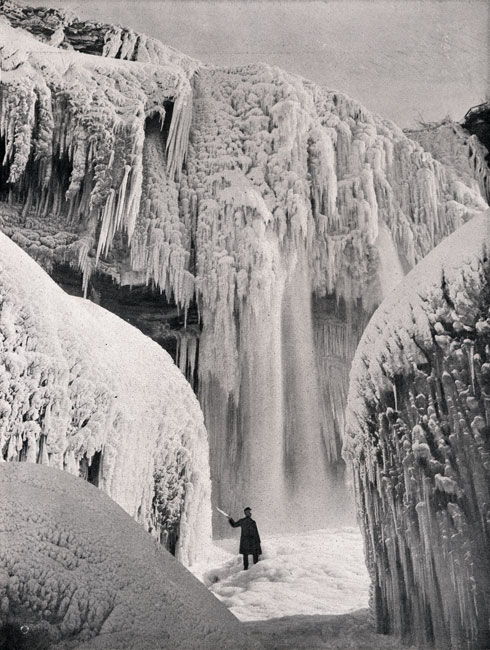
Cave of the Winds area, 1896. Image source: "Grandeurs of Niagara"
"On the morning of February 14, 1896, John R. Barlow, the famous guide of the Cave of the Winds, discovered that this wonderful and mighty cavern under the Centre Fall was dry. For four days the waters of the fall were held back by the ice formation, and for the first time in fifty or more years humanity sought the cavern depths and roamed about in great glee, admiring the remarkable ice formations on every side. It was a spectacle few ever see, and at that time it was possible to walk in front of the American Fall on the ice bridge. Such photographs as that above may never again be obtained. In all his years Guide Barlow had never before entered the Cave in winter time." ("Grandeurs of Niagara")
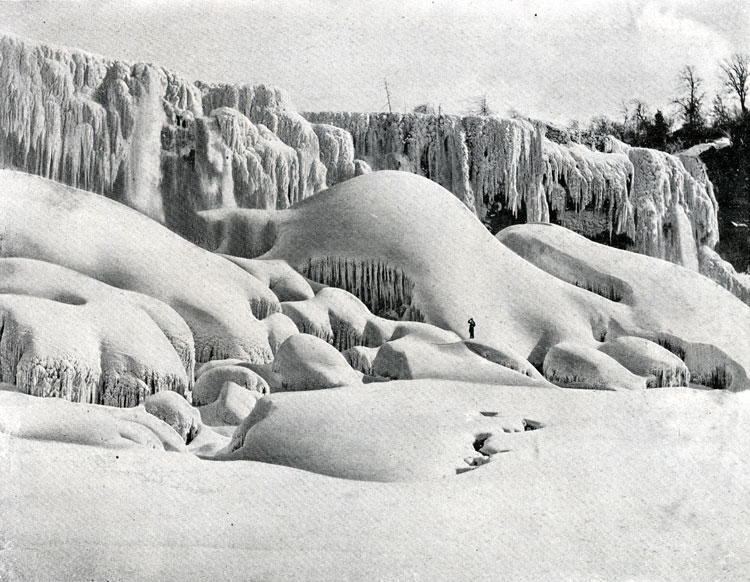
Ice Mountain, American Falls, 1900. Image source: private collection
"...to many people these ice mountains and the crystal formations on the foliage and everything about the falls is more beautiful and wonderful than the falls themselves.These mountains are not a solid body of ice but rather heaps of granulated water. The are formed by large cakes of ice coming over the falls in cold weather and lodging on the rocks below. The spray, continually rising from the turbulent water, turned into small grains of ice, falls back and finds lodgement on the anchored ice. Thus the mountains are gradually built up until they attain the full height of the falls if the cold weather continues long enough." ("Grandeurs of Niagara")
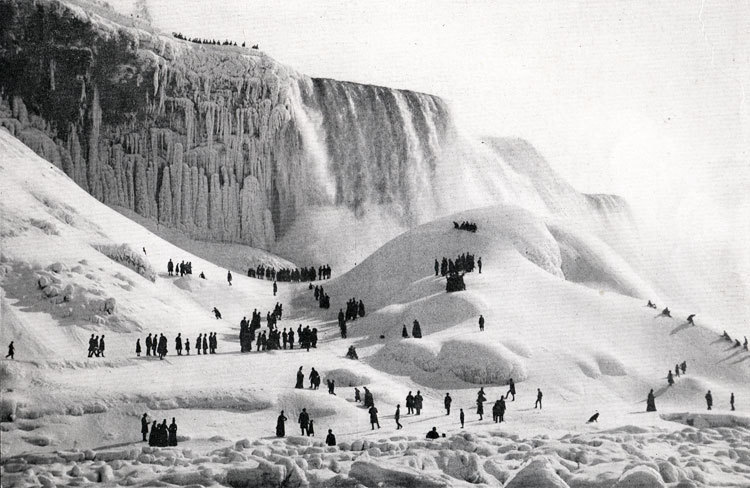
Ice Mountain seen from the Ice Bridge, c 1899. Image source: private collection
On the formation of the ice bridge, the Buffalo Express said, "In almost a single moment it is formed. A moment before the ice blocks, ground down on their flight over the falls, have been in sullen churning motion, greenish-white in the river. Then they are locked in a stiff embrace, slender at first, but tightening each moment. Thereafter there is movement often - the opening of great crevices, the upward thrust of the ice as it joins the mass until often the ice bridge is a truly tremendous affair many yards in thickness.
"With the formation of the bridge the winter season has properly begun. The daring on both sides as a matter of custom strive to see who shall be the first to cross upon this dangerous passageway. The surface of the bridge, which often seems so smooth seen from the bank above, is tumultuous, indeed. Its surface is really the height of fantastic irregularity. But skilled by a knowledge of the bridges of other years the pioneers each year map out a path which is followed for the rest of the season. Along this path small shanties appear, the pre-emption of this neutral ground by unlicensed saloonkeepers. Exemption from taxation seems a great boon and a parlous sort of whiskey may be obtained at very moderate rates by any to whom the majesty of the surroundings seems not too incongruous for drinking."
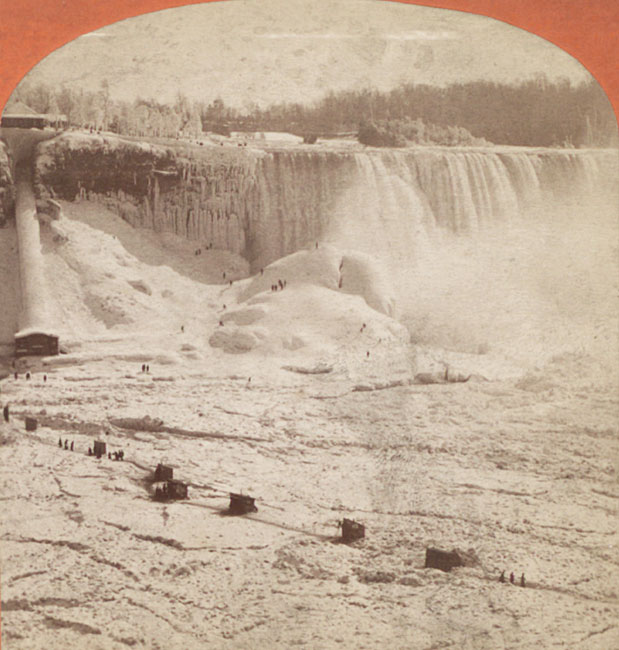
Stereoview showing the Ice Bridge, by George Barker, date unknown. Image source: NYPL
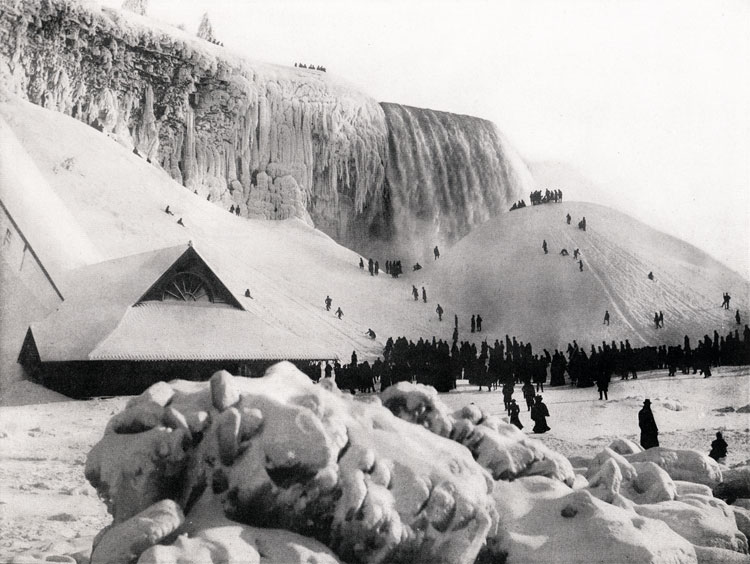
Sledding down the Ice Mountain in Front of the American Falls, 1900. Image source: "Grandeurs of Niagara"
The "ice bridge" formed periodically in the years before the Ice Boom was installed at the mouth of the Niagara River in Buffalo in 1964. It did not form every year but was a feature found in February and March during very cold winters. Ice chunks from Lake Erie floated down the river and were smashed into bits no larger than a bushel basket by the force of the falls. These gathered at the banks on both sides of the basin below the falls. Cold temperatures froze them and gradually the bridge was built up, seemingly solid from side to side. Ice bridges lasted from several hours to weeks; the water underneath never stopped flowing and the bridge could break up without warning except a telltale groan that gave a few minutes' warning.
None of this was regulated by law and safety was a tourist responsibility. Inevitably, ice bridges failed while a few people were far from the banks and didn't hear or heed the warning of impending breakup. Stories of dramatic rescues from ice floes that broke free as well as heartbreaking deaths from those swept along and into the whirlpool rapids downstream have been recorded. After a particularly gruesome triple death in 1912, authorities declared the ice at the base of the falls off-limits forever. Photos exist from 1936, however, which demonstrate that people were still willing to take the risk for an unparalled view of Niagara Falls.
George Barker was a Canadian photographer who made his reputation in th 1860s as a photgrapher of Niagara Falls. He had studios in both London, Ontario and Niagara Falls, NY. He was particularly known for his large-format prints of the Falls, now in the collections of major institutions in Canada and the U.S. At the time of his death in 1894, fellow photographers ranked him as "the eminent photographer of Niagara Falls."
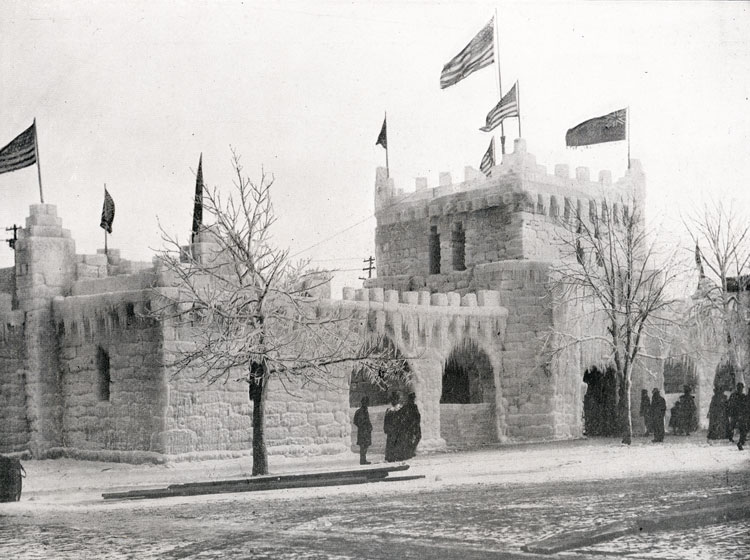
Ice Palace, c. 1899. Image souce: "Grandeurs of Niagara"
In January 1899, the Niagara Falls Tourist and Convention Association conceived of a winter carnival to stimulate visitors. The keystone of the festival was an ice palace constructed at the corner of Riverway and Niagara Street (the approximate location of the Rainbow Bridge toll gates in 2013). The Association interested the railroad companies which provided some funds and they also sold stock. The carnival ran on a Saturday and Sunday, January 28 and 29. The design of the ice palace, by H.W. Beardsley and W.H, Barnes, was to have been larger than finally constructed because a thaw intervened and required the purchase of more ice from companies in Niagara Falls, Buffalo, and St. Catharines, Ontario. The final structure was 120 x 160 feet, with walls three to seven feet thick. The interior was lit by electricity and contained an ice rink and a hockey rink where games and contests were held. Outside the ice palace, a toboggan slide had been constructed. Although it was a success, it did not make a profit and does not seem to have been replicated in later years.
